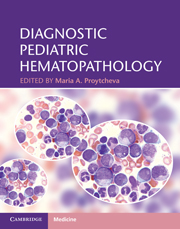Book contents
- Frontmatter
- Contents
- List of contributors
- Acknowledgements
- Introduction
- Section 1 General and non-neoplastic hematopathology
- Section 2 Neoplastic hematopathology
- 10 Chromosome abnormalities of hematologic malignancies
- 11 Expression profiling in pediatric acute leukemias
- 12 Myeloproliferative neoplasms
- 13 Myelodysplastic/myeloproliferative neoplasms
- 14 Myelodysplastic syndromes and therapy-related myeloid neoplasms
- 15 Acute myeloid leukemia and related precursor neoplasms
- 16 Hematologic abnormalities in individuals with Down syndrome
- 17 Precursor lymphoid neoplasms
- 18 Advances in prognostication and treatment of pediatric acute leukemia
- 19 The effect of chemotherapy, detection of minimal residual disease, and hematopoietic stem cell transplantation
- 20 Pediatric small blue cell tumors metastatic to the bone marrow
- 21 Pediatric mature B-cell non-Hodgkin lymphomas
- 22 Pediatric mature T-cell and NK-cell non-Hodgkin lymphomas
- 23 Hodgkin lymphoma
- 24 Immunodeficiency-associated lymphoproliferative disorders
- 25 Histiocytic proliferations in childhood
- 26 Cutaneous and subcutaneous lymphomas in children
- Index
- References
22 - Pediatric mature T-cell and NK-cell non-Hodgkin lymphomas
from Section 2 - Neoplastic hematopathology
Published online by Cambridge University Press: 03 May 2011
- Frontmatter
- Contents
- List of contributors
- Acknowledgements
- Introduction
- Section 1 General and non-neoplastic hematopathology
- Section 2 Neoplastic hematopathology
- 10 Chromosome abnormalities of hematologic malignancies
- 11 Expression profiling in pediatric acute leukemias
- 12 Myeloproliferative neoplasms
- 13 Myelodysplastic/myeloproliferative neoplasms
- 14 Myelodysplastic syndromes and therapy-related myeloid neoplasms
- 15 Acute myeloid leukemia and related precursor neoplasms
- 16 Hematologic abnormalities in individuals with Down syndrome
- 17 Precursor lymphoid neoplasms
- 18 Advances in prognostication and treatment of pediatric acute leukemia
- 19 The effect of chemotherapy, detection of minimal residual disease, and hematopoietic stem cell transplantation
- 20 Pediatric small blue cell tumors metastatic to the bone marrow
- 21 Pediatric mature B-cell non-Hodgkin lymphomas
- 22 Pediatric mature T-cell and NK-cell non-Hodgkin lymphomas
- 23 Hodgkin lymphoma
- 24 Immunodeficiency-associated lymphoproliferative disorders
- 25 Histiocytic proliferations in childhood
- 26 Cutaneous and subcutaneous lymphomas in children
- Index
- References
Summary
Mature T-cell lymphomas in children and adolescents comprise about 10–15% of the non-Hodgkin lymphomas (NHLs) observed. Unlike adults, where there is a broad spectrum of T-cell neoplasms, most mature T-cell disease in this age group is ALK (anaplastic lymphoma kinase)-positive anaplastic large cell lymphoma (ALCL, ALK positive), with other subtypes of T-cell lymphomas being much more rarely observed (Tables 22.1 and 22.2). Similarly, although NK-cell neoplasms are rare in adults, comprising approximately 1–2% of NHL (although with higher frequency in Asia and Latin America), these neoplasms are extremely rare in children and most appear in the literature as single case reports or small series. As in adults, mature T- and NK-cell lymphomas tend to present with a broad spectrum of clinical disease including nodal, extranodal, and leukemic diseases, and are frequently associated with paraneoplastic phenomena such as hemophagocytosis, fevers, rashes, and other manifestations that may be, in part, attributable to cytokines produced by the neoplastic cells [1, 2].
Epidemiology
Mature T- and NK-cell lymphomas are rarer than B-cell disease in North American and European populations. However, there are significant differences in geographic distribution, with higher incidences of T/NK-cell lymphoma in adults in Asia and Latin American populations than are seen in the United States and Europe. In Asia, T-cell lymphomas in adults make up 30–70% of all NHLs, whereas in the pediatric population they make up about 37% of cases [3, 4].
- Type
- Chapter
- Information
- Diagnostic Pediatric Hematopathology , pp. 429 - 464Publisher: Cambridge University PressPrint publication year: 2011



